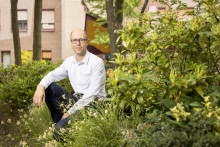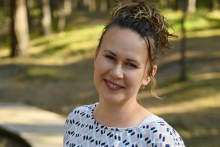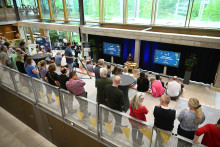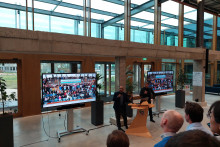Thomas Groen was elected ‘Teacher of the Year’ by students in the Faculty of Geo-Information Science and Earth Observation (ITC) this year. His award might have come as a surprise to him, but it is very appreciated. The award is sometimes regarded a bit as a popularity contest: the teachers who know how to make education ‘fun’ are the ones that get thrust into the spotlight. But making education fun is exactly what Groen likes to do, and recognition of this is warmly received.
So what does he think is particularly important when it comes to teaching? His unwritten rule is that the fun things tend to stick in the memory better. And that depends on creating a particular type of atmosphere. A lecture hall should feel like home for the students and there should be plenty of room for asking questions, no matter how ‘silly’ they might seem to be. Groen isn’t someone who thinks that stupid questions don’t exist, but he does believe that every student should feel comfortable to ask a potentially stupid question. After all, he believes that the road to understanding is made up of a chain of steps; such a chain is only as strong as its weakest link. Where there is a vulnerability, people run the risk of ending up in trouble if the subject matter becomes more complex down the line.
That is why he encourages asking questions and making mistakes. During lectures, for example, he regularly picks ‘volunteers’ to come forward. The more mistakes they make, the better. After all, he prefers the mistakes are made during lectures rather than during exams. Above all, what he wants to encourage is a sense of togetherness in the group. He would like to see that one of the curious students in the front row offers help when somebody else is visibly struggling. And he also wants to encourage those students who sit at the back of the room – not attracting any attention and potentially suffering in silence – to participate in the group process. It’s not in every bodies nature to cross the threshold and take part in a plenary discussion, or even to approach a teacher individually no matter how approachable you are as a teacher.
He finds the diversity of the student population to be an interesting and enjoyable challenge: the various differences in backgrounds, cultures, knowledge, educational systems students come from and personalities. Each individual offers their own perspective. And that is exactly what’s important in the ITC Master's Programme in Spatial Engineering, of which Groen is also the Programme Director. Students work on so-called wicked problems which are not preconceived, clearly defined assignments. Wicked problems require to work together and find solutions to almost intangible challenges such as food security and climate change. It is then down to the students, as empathic engineers, to take account of everyone's perspectives and to come up with solutions.
Groen is the first to admit that this programme is not for everyone: particularly those who want to deeply immerse themselves in a specialism should look elsewhere. But he believes that Spatial Engineering is the perfect choice for students who have a helicopter view; those who can bring together different viewpoints, grasp an ongoing overview of matters, and who have the required soft skills to make the link between engineers and non-engineers. This is about more than simply sitting around the table with stakeholders.
The ITC lecturer has also tried to weave his research into what he teaches, especially when it comes to species distribution modelling. Using models, Groen for example tries to predict where you can find disease-carrying insects. Applying research in this way appeals to the imagination of many people, but actually, it is predominantly about statistics. Statistics can be boring, which is why you need appealing examples to give it meaning. Statistics, according to Groen, are not much different from using a hammer. A hammer is a tool that doesn’t appeal to the imagination, but is something that is appreciated when you see what you can make using it – in the right hands, of course.
In that respect, Groen believes that education has been too much underrated at Universities for a long time now. Despite having nothing but respect for fellow scientists who are awarded prestigious grants, Groen would like to see this lopsided relationship between research and education rebalanced. He does understand it in part: research is easier to quantify using hard metrics. Good teaching, however, is less easy to quantify. How successful people are and their impact on the world after they graduated can only translate into alumni success stories that you can only find out several years later.
But that is precisely where Groen gets his passion for teaching: educating people who then make the world a little better and more beautiful. For him, it is also about a sense of duty. Students make the effort to sometimes come from many miles away just so they can put their future in your hands. As a teacher, you have a duty to allow people to grow so that once they have graduated, they can begin to leave a positive mark on the world.
And Groen is happy to acknowledge that this cannot always be measured.







